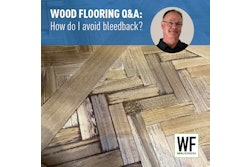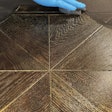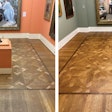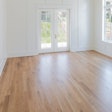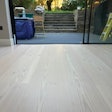
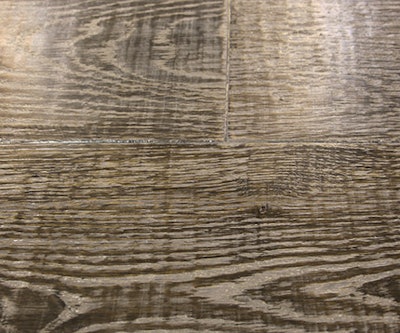
A few years ago, we had a situation where a reclaimed floor had to be repaired in a hurry, but it was going to take six weeks for us to get the same reclaimed flooring, which was a red oak and white oak unfinished product. The customer couldn't wait that long, so we had to be more creative. We were able replicate the same appearance of the reclaimed floor with new wood flooring by using an old-school method: a vinegar and steel wool solution.
This solution is often referred to in our trade as "iron acetate," although from a chemistry perspective, a true iron acetate would need to be more refined. Whatever you call it, the solution has a chemical reaction with the tannins in wood. When applied to a wood floor, the reaction changes the wood to a gray color. How dark the wood gets depends on the species: the more tannins, the more dramatic the color change. The color change is different from the color change created by stains and dyes, which use solvents and pigments to color the wood; the color change with the iron acetate is a chemical change in the wood itself.
RELATED: Wood Floor Finish 101: The Low-Down on Today’s Finishes
Today this solution is a typical process in our wood flooring business. While we do plenty of wood floors for your average wood flooring consumer, we also do a fair amount of business for high-end clients and designers, and we find this process useful when they are trying to match their wood floor to a custom cabinet or to accentuate their granite. They want something different from their neighbors, and we can combine this process with different stains, dyes, paints and finishes to offer almost endless possibilities in terms of custom color effects. Because the cost is so low—just vinegar and steel wool—it saves a substantial amount of money both for us and our customers, too, compared with other methods to achieve the same effects.
How-To Basics
Sometimes people are skeptical when they hear about this method because it sounds too simple. The process is straightforward: You soak steel wool (I usually use 4/0 pads, but you can use different grades and/or bolts) inside a bucket of vinegar. I use plain vinegar, although I've read online where people have used red wine or other vinegars, which I assume would create a different color.
Sometimes people are skeptical when they hear about this method because it sounds too simple.
The soaking time affects how dark the vinegar will turn the floor. I've done testing where I let the mixture soak for 12, 24, 36 and 48 hours. After 36 hours I don't notice much of a difference in how dark the floor gets, but I usually let my mixture soak for 48 hours as a standard practice. The solution should stay a clear color; in my experience if it soaks so long that the solution starts to turn a rusty color, it seems to lose its strength.
Before applying the mixture, I strain it through coffee filters twice. This is a good idea no matter what finish you plan to use, but particularly important if you plan on using waterborne finish, which could react with any steel wool particles on the floor to create small black spots.
Applying the vinegar mixture to the floor is similar to the process for water-popping a floor: You want to apply it evenly and make sure it is completely dry before going to your next step, whether that's a stain, dye, paint or finish. Just as when water-popping, take a moisture meter reading of the wood floor before you apply the solution, then wait for it to go back to that same moisture content before the next step.
For small jobs, I apply it with a rag just like I would when staining the floor, although you can also use a T-bar or lambswool applicator. On bigger jobs, I'll use a bug sprayer. It's easier and also avoids the potential issue of too much wood dust from the floor collecting on the rag and affecting the solution every time you re-dip the rag in the bucket. The iron acetate solution isn't nearly as difficult to apply as an aniline dye, for example, but you do want to apply it as evenly as possible.
RELATED: Get a Handle on Wood Floor Staining Strategies
Different Effects
Just as with stain, how open or closed the grain is will affect how dark the solution makes the floor. Unlike stain, this solution will make the floor darker each time you apply it and won't cause problems with multiple coats.
Since this solution creates the color reaction with the tannins in the wood, the amount of tannins in each species and each board makes a dramatic difference on how much color change is created by this solution. As we all know, white oak has a lot of tannins, so it experiences a lot of change: Iron acetate typically makes a white oak floor look gray with brown undertones. Where the white oak has a tighter grain, the color will be lighter.
It may sound strange, but to make the effect darker, we coat the wood floor with black tea first.
Tight-grained species with low tannin levels such as maple and hickory won't show much change with just a straight vinegar/steel wool solution, but there is another old-fashioned, low-cost option to help with those species. It may sound strange, but to make the effect darker, we coat the wood floor with black tea first. You can simply steep some black tea with water, then coat the floor with it just like you do the vinegar/steel wool solution. Again, you need to wait for the floor to dry before your next step.
You can get other color effects by adding other colors right into the vinegar/steel wool solution. We've used food coloring as well as aniline dye mixed in with the solution to create different colors. Of course, if you do that, you need to be extremely careful with even application to avoid lap marks and other issues that commonly happen when using dyes.
Reducing Your Risk
As you've already realized, this process, while being tested throughout the years, falls into the category of what I refer to as "tailgate chemistry." Any time you venture into tailgate chemistry territory, you need to do plenty of testing on the floor with the exact process you intend to use on the job site, because your finish manufacturer isn't going to stand behind products not used as directed. Test the product with your finish: Does it bubble? Flake? Turn a weird color? You don't know until you try it. Do adhesion tests and see if you can make the finish fail.
Experimenting with this process is kind of like being a mad scientist. You can try different species, stains, sanding effects, etc., and mix up the order of the steps you use for different looks. Note that the reaction with the vinegar/steel wool solution doesn't necessarily happen right away. One day I was experimenting in the shop with my young son, and he said I should apply the solution after I put a white stain on the boards. When I tried it, I thought it didn't do anything, but when I came back 45 minutes later, it had turned more of a blue color. I set the sample in my showroom, and we sold a job with that color four days later.
I keep a detailed recipe for every single sample so I can reproduce it accurately.
As you go forward with your experiments, be diligent and record everything precisely. I keep a detailed recipe for every single sample so I can reproduce it accurately. I used to keep the recipes on the back of the samples, but I learned that when I was letting customers take samples home, I was also giving our competitors our exact formulas for these custom effects. Now I create a proprietary name and keep the recipes on file.
RELATED: Step by Step: How to Apply Stain to Wood Floors
One straightforward use for the iron acetate solution is creating a black floor. By far the easiest ebony floor we have ever done was created by using the iron acetate solution on the floor, then applying a black stain. When creating a black floor, you usually water-pop the floor anyway, so using the solution doesn't add an extra step but has the added bonus of making the floor even darker (I find it makes the floor just as dark as using a dye).
Another helpful way to use this solution is to help make the floor darker when buffing on stain. Many contractors like to buff on stain but sometimes avoid it because the floor ends up being lighter than it would if you ragged the stain on. If you use this solution first, you can buff the stain on and get the floor just as dark as if you ragged it on.
As you can tell, the possibilities for using this old-school technique for darkening floors are nearly limitless. In a wood flooring market like the one today, where customers are asking for more unusual and varied custom effects than they ever have before, this is a good technique to have on hand—for little cost—in your wood flooring arsenal.
|
||||||||||||
Ammonia EffectsOccasionally we'll use ammonia on a wood floor for a special effect. When you put it onto wood and apply heat with a heat gun, it creates a black effect like a brand. We've used this with large stamps like crafters use—we dip the stamp into a tray of ammonia, apply the stamp onto stair risers, then use the heat gun to reveal the pattern of the stamp on the riser for an interesting custom effect.—J.E. |
Watch a short video of author Jason Elquest discussing his techniques and samples:






















